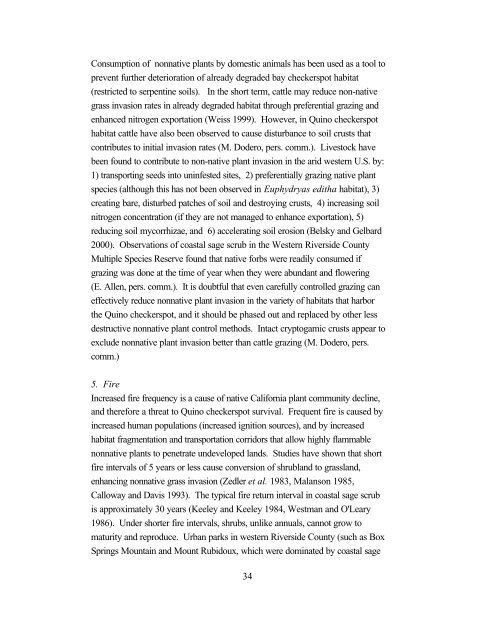Outline of Quino Recovery Plan - The Xerces Society
Outline of Quino Recovery Plan - The Xerces Society
Outline of Quino Recovery Plan - The Xerces Society
You also want an ePaper? Increase the reach of your titles
YUMPU automatically turns print PDFs into web optimized ePapers that Google loves.
Consumption <strong>of</strong> nonnative plants by domestic animals has been used as a tool to<br />
prevent further deterioration <strong>of</strong> already degraded bay checkerspot habitat<br />
(restricted to serpentine soils). In the short term, cattle may reduce non-native<br />
grass invasion rates in already degraded habitat through preferential grazing and<br />
enhanced nitrogen exportation (Weiss 1999). However, in <strong>Quino</strong> checkerspot<br />
habitat cattle have also been observed to cause disturbance to soil crusts that<br />
contributes to initial invasion rates (M. Dodero, pers. comm.). Livestock have<br />
been found to contribute to non-native plant invasion in the arid western U.S. by:<br />
1) transporting seeds into uninfested sites, 2) preferentially grazing native plant<br />
species (although this has not been observed in Euphydryas editha habitat), 3)<br />
creating bare, disturbed patches <strong>of</strong> soil and destroying crusts, 4) increasing soil<br />
nitrogen concentration (if they are not managed to enhance exportation), 5)<br />
reducing soil mycorrhizae, and 6) accelerating soil erosion (Belsky and Gelbard<br />
2000). Observations <strong>of</strong> coastal sage scrub in the Western Riverside County<br />
Multiple Species Reserve found that native forbs were readily consumed if<br />
grazing was done at the time <strong>of</strong> year when they were abundant and flowering<br />
(E. Allen, pers. comm.). It is doubtful that even carefully controlled grazing can<br />
effectively reduce nonnative plant invasion in the variety <strong>of</strong> habitats that harbor<br />
the <strong>Quino</strong> checkerspot, and it should be phased out and replaced by other less<br />
destructive nonnative plant control methods. Intact cryptogamic crusts appear to<br />
exclude nonnative plant invasion better than cattle grazing (M. Dodero, pers.<br />
comm.)<br />
5. Fire<br />
Increased fire frequency is a cause <strong>of</strong> native California plant community decline,<br />
and therefore a threat to <strong>Quino</strong> checkerspot survival. Frequent fire is caused by<br />
increased human populations (increased ignition sources), and by increased<br />
habitat fragmentation and transportation corridors that allow highly flammable<br />
nonnative plants to penetrate undeveloped lands. Studies have shown that short<br />
fire intervals <strong>of</strong> 5 years or less cause conversion <strong>of</strong> shrubland to grassland,<br />
enhancing nonnative grass invasion (Zedler et al. 1983, Malanson 1985,<br />
Calloway and Davis 1993). <strong>The</strong> typical fire return interval in coastal sage scrub<br />
is approximately 30 years (Keeley and Keeley 1984, Westman and O'Leary<br />
1986). Under shorter fire intervals, shrubs, unlike annuals, cannot grow to<br />
maturity and reproduce. Urban parks in western Riverside County (such as Box<br />
Springs Mountain and Mount Rubidoux, which were dominated by coastal sage<br />
34
















